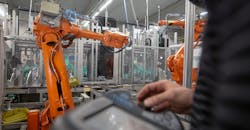According to the McKinsey Global Industrial Robotics Survey, automated systems will account for 25% of capital spending over the next five years. Many businesses believe robotics-driven automation will drive major benefits in output quality, efficiency, and uptime.
But there are challenges for these implementations to be successful, including the cost of investment, experience in deploying projects, and the belief that more robotics will mean less reliance on human capital.
Several industries are expected to see major growth in the use of robotics and automation, such as retail and consumer goods (23% of retail survey respondents plan to spend more than $500 million) versus 15% in food and beverage and 8% in automotive.
Robotics and automation continue to grow
The fundamental benefits of robotics and automation cannot be ignored and virtually every industrial deployment will result in a more intelligent use of resources. In most cases it frees human employees from mundane, repetitive tasks and empowers them to concentrate on core business objectives instead, bringing about numerous benefits to the workplace.
In the early days of robotics, there was plenty of chatter that robots will eventually outsmart humans and there will be less need for human capital. This has clearly not been the case, nor is it today’s path for robotics and automation.
However, they will represent a considerable amount of the average industrial company’s production strategy. According to a March 2017 report on automation in the workplace by PricewaterhouseCoopers, as many as 30% of jobs in the U.K., 38% of jobs in the U.S., 35% of jobs in Germany, and 21% of jobs in Japan are at risk of being replaced by machine-based automation by the early 2030s.
Even more recently, 10.5 million jobs remained open, with roughly 1.7 jobs available per worker at the end of November 2022. While low headcounts seem to be the new norm, robotics are not replacing anyone, but are filling the gaps that cannot be covered with labor. Robotics tend to do the least desirable and most repetitive jobs in the supply chain.
Even with more robotics, human labor will be key
There are reasons that humans and human labor will continue to play a significant role.
Robots do not understand emotional thoughts. Robots operate on rationally programmed logic. However, there will always be irrational variables that involve emotional, critical thinking in the decision-making process. This is why human labor will be important in supervising robotics so that changes can occur depending on any number of irrational changes to the environment.
Robots cannot understand context. Especially for manufacturing jobs that require analysis, or the interpretation of slang from different countries and cultures, some robotics and automation may struggle in these types of warehouse production roles.
Robots don’t understand customer service. Robotics and automation may continue to prove challenging as industrial companies try to implement these functions into remote customer site visits, e.g., for service and repair. AI-powered robotics will always be programmed to deliver the most pragmatic solution without any consideration of how it affects future customer relationships.
In each of these scenarios, robotics can play a role but not without human interaction. Thus, successful industrial companies are leveraging labor management technologies to better manage the relationship between human capital and robotics. In a recent industrial-focused survey, 36% of executives said they leverage labor management system technology for their warehouse operations, and 29% said they plan to invest in such technology in 2023.
Why is labor management necessary for robotics?
These companies are relying on labor management technologies to inject more flexibility to adapt to a fast-evolving marketplace using robotics and automation. It allows for greater productivity and efficiency from logistics and warehouse personnel to support everything from increasing customer demand to rapid shifts in the use of robotics and automation programs on the floor.
Today’s advanced labor management solutions can leverage historical robotics data to create smarter performance tracking across the life of each automated system without complex and costly projects. In many cases, companies can leverage this technology to reduce data refresh from eight hours of programmed analysis down to just a couple of minutes, for more real-time decision-making of labor needs.
Robotics and automation will continue to grow throughout the industrial commercial landscape. But without using intelligent labor management technology, companies will not efficiently and effectively manage their robotics systems for optimal logistics and warehouse functions.
Mike Babiak is the Director of Supply Chain Technology Strategy for Longbow Advantage.
About the Author
Mike Babiak
Director of Supply Chain Technology Strategy
Mike Babiak is the Director of Supply Chain Technology Strategy for Longbow Advantage.
